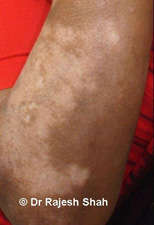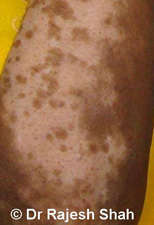Homeopathic Medicines for Vitiligo Treatment
There are about thirty-odd homeopathic medicines, that might get indicated for the treatment of vitiligo, depending on individual patient’s parameters, in terms of:
- Nature and extent of vitiligo
- Probable causes of vitiligo
- Genetic factors indicated by a family history of certain diseases (e.g., autoimmune diseases, tuberculosis, cancer, hormonal disorders, etc.)
- Emotional makeup of the patient: Patient’s reactive and behaviour pattern, some prominent emotions, the impact of emotional circumstances, etc.
- Physical factors such as thermal sensitivity, natural preference for food, etc.
Some of the commonly used remedies have been described in brief here. It must be noted that the description offered herewith is neither complete nor exclusive; as there is flexibility on the part of a qualified homeopath to make prescriptions based on one’s clinical judgment.
Besides some of the following ingredients, the product contains Dr Shah's internationally Patented, Research-based, highly effective medicines.
Dr Shah's patented molecules
- Kali Carbonicum
- Silicea
- Arsenicum Sulfuratum Flavum
- Syphillinum
- Nitricum Acidum
- Carcinosin
- Hydrocotyle Asiatica
- Natrum Muriaticum
- Phosphorus
The following photos simply demonstrate how homeopathic medicines stimulate re-pigmentation. Please click photos to enlarge.


(Re-pigmentation demonstrated with research-based molecules at Life Force.)
Kali Carbonicum: Potassium carbonate undergoes the process of potentization to evolve into a powerful deep-acting homeopathic remedy called Kali Carb. Kali carb is a polychrest drug i.e. having effects on multiple organs and systems in the body. It has a broad sphere of action and is useful for a wide range of diseases.
Kali Carbonicum positively influences the lungs, digestive system, heart, liver, kidney, female reproductive system, skin, etc. Kali Carbonicum does wonders in cases of asthma, bronchitis, tuberculosis, pneumonia, hydrothorax, etc. It is one of the commonly used remedies for vitiligo, warts, eczema, urticaria, hair loss, trigeminal neuralgia, sciatica, low backache, hypothyroidism, heavy menstrual bleeding, etc. It is also useful for complaints of the digestive system like acidity, piles, jaundice, gastritis, etc. In the mental sphere, it tackles anxiety states very efficiently and is used for the treatment of the effects of stress on the body.
Homeopathic treatment for vitiligo
Silicea (Silica):
It is one of the splendid acts of homeopathy that substances labelled as inert can also be used effectively to treat a large variety of disorders. Silica is an example of one such substance, which is chemically inert in its natural form, but after undergoing the process of potentization it gets transformed into a wonderful, deep-acting remedy. Silica is in a true sense called a polychrest remedy as it has a broad spectrum of action, useful for a wide range of disease processes. This remedy has helped Homeopaths the world over to treat so-called surgical conditions gently without requiring a knife.
This drug is prepared from the metal Silica (Si), sand. It is a popular remedy for those vitiligo patients who are sensitive to the cold wind (breeze, air-conditioners, winter); who tend to sweat on palms and soles; have typically offensive foot-sweat; have lean-thin physical body structure, and may additionally tend to have easy pus formation after injury.
Arsenicum Sulfuratum Flavum:
Arsenicum sulfuratum flavum, known by various names such as Arsenicum sulphuratum aureum or Arsenicum sulphuratum natronatum, stands out as a specific remedy in homeopathy treatment for Vitiligo. Its therapeutic reach extends to catarrhal affections and asthmatic states, showcasing its deep-acting properties with positive outcomes in cases of Leucoderma (Vitiligo). Characterized by pale or white blotches on the skin, this remedy is particularly considered when a burning sensation accompanies Vitiligo patches. It addresses cases where Vitiligo exhibits rapid spreading, and individuals may experience moist eruptions or oozing from affected patches.
Further indications for Arsenicum sulfuratum flavum involve itching or pricking sensations in Vitiligo-affected areas. Symptoms tend to intensify during the night, contributing to restlessness in affected individuals. This remedy is often recommended for those who harbour feelings of anxiety, restlessness, and a fear of the future. The manifestation of dryness and cracking of the skin, particularly around Vitiligo patches, is another facet where Arsenicum sulfuratum flavum may prove beneficial. Its versatile applications make it a noteworthy consideration in the holistic approach to Vitiligo treatment within the realm of homeopathy.
Syphillinum:
Syphilinum belongs to a group of homeopathic drugs called Nosodes which are prepared from disease products or diseased tissues. The remedy prescribed does not contain the original drug substance in the material form but it contains only the dynamic curative powers of that substance. This is achieved through the process of potentization in homeopathy. Syphillinum is a deep-acting, polychrest remedy affecting multiple systems of the body.
It positively influences the mind, sensorium, skin, gastrointestinal tract, genito-urinary system, nerves, bones, etc. It is a very helpful remedy to combat hereditary syphilitic tendencies in patients.
Syphillinum is frequently used in the homeopathic treatment of vitiligo, recurrent abscesses, osteomyelitis, trigeminal neuralgia, alcohol dependence, rheumatic complaints, etc. It's a useful drug to combat diseases that are destructive in nature and are deep-seated.
Nitricum Acidum:
As the name suggests, this drug is prepared from nitric acid. It must be remembered that the remedy does not contain the original drug substance in its material form but it contains only the dynamic powers of the drug which are released after it undergoes the process of potentization.
Nitricum Acidum is a deep-acting, constitutional remedy that positively influences the gastrointestinal tract, nerves, glands, skin, bones, etc.
It is one of the most commonly used drugs for vitiligo, warts, ulcers, fissures, gastritis, hemorrhoids, bony and rheumatic affections, malignancy, cachexia, etc.
Carcinosin:
It's the beauty of the homeopathic system of medicine to be able to use not only plants, animal products, and minerals but also certain disease products and diseased tissue for curing various ailments of patients. These are called Nosodes. Here is a remedy prepared from the material derived from the carcinoma of the breast. It must be borne in mind that the actual medicine does not contain any part of the original substance in the material form. Only the dynamic powers of the original drug substance are present in the final medicine.
Carcinosin is a deep-acting constitutional drug having many indications and a very broad spectrum of action. It is useful for a wide range of disease processes, all of them cannot be described here, but a few of them are discussed here. It positively influences the mind, lungs, heart, eyes, skin, bones and joints, nerves, etc. It is one of the commonly used remedies for diseases like vitiligo (Leucoderma), urticaria, lichen planus, styes and chalazion, hair loss, asthma, insomnia, trigeminal neuralgia, etc. Homeopathy believes that the genetic predisposition or inherent susceptibility is usually the root cause of a wide range of diseases and Carcinosin is one such remedy that is used to combat these genetic tendencies effectively.
Hydrocotyle Asiatica:
Hydrocotyle asiatica, also known as Centella asiatica or Gotu Kola, is derived from the Indian Pennywort plant, and its preparation involves using the tincture from the entire fresh plant. Through the process of potentization, the remedial properties of this preparation are activated. Recognized as one of the effective Vitiligo homeopathic medicine, Hydrocotyle asiatica is believed to stimulate the pigmentation process.
This remedy is commonly considered when Vitiligo exhibits a slow progression over time, accompanied by the development of milk-white spots on the skin. Individuals experiencing itching and a burning sensation in the affected areas may find relief through the use of Hydrocotyle asiatica. In some cases, the remedy is associated with moist eczematous eruptions related to Vitiligo patches. Dry and cracked skin around the Vitiligo patches.
Hydrocotyle asiatica is not only beneficial for Vitiligo but also for various other skin conditions, including psoriasis, lupus, leprosy, acne, and disorders involving significant skin exfoliation. It is often prescribed in combination with a constitutional medicine or other deeper-acting remedies to achieve optimal effects.
Natrum Muriaticum:
Natrum Muriaticum is an interesting example of homeopathic medicine prepared from a common food substance, the common salt, sodium chloride. As a rule, the common salt undergoes a special procedure called potentization, whereby its inner healing power is activated to make it available for healing. Constitutionally, this medicine has a broad spectrum of action and is useful for a wide range of disease processes affecting the skin, gastrointestinal organs, nose, lungs, kidney, metabolism, muscles, head, hormonal system, etc. It is a commonly used remedy for hair loss, fissures-in-ano, urticaria, migraine, eczema, lichen planus, vitiligo, asthma, etc. Natrum muriaticum is frequently prescribed in cases of vitiligo and is one of the very good remedies for the same.
Phosphorus:
This is a wonderful remedy prepared by the potentization of inorganic phosphorus. After undergoing the process of potentization, the latent healing powers of this drug are brought to the surface and it proves to be a wonderful remedy capable of curing a wide range of diseases.
Phosphorus predominantly acts on the skin, gastrointestinal tract, hepatobiliary system, blood, kidneys, bones, lungs, nervous tissue, etc. It is frequently used in the homeopathic treatment of vitiligo (Leucoderma), hair loss, nephrotic syndrome, hepatitis, cirrhosis, hemorrhagic tendencies, respiratory infections, osteomyelitis, paralytic symptoms, etc.
A few of its common skin symptoms are Loss of pigmentation in spots and white discolouration of the skin. It is also used for skin disorders where the patient has much itching and burning of the skin; in urticaria, psoriasis. It is also a good drug for hemorrhagic spots occurring on the skin at various places.
Phosphorus is frequently indicated in cases where Vitiligo is rapidly spreading across a significant area of the skin. This remedy is particularly considered for individuals who exhibit sensitivity to light, especially sunlight. A distinctive symptom associated with Phosphorus is the presence of a burning sensation in the skin. Those who tend to feel warm and have a propensity to flush easily may find Phosphorus beneficial. Additionally, a notable characteristic of Phosphorus is an increased thirst for cold water.
Emotionally, individuals who may benefit from Phosphorus often display sensitivity and compassion. They may seek attention and affection from others. Furthermore, there is a tendency for these individuals to desire company and reassurance, particularly experiencing feelings of anxiety and fear when left alone.
Note: • There are over 30 commonly indicated medicines for Vitiligo. Exact medicines are selected based on individual case history and symptoms. • Please avoid self-medication with any of the above medicines, as it may not work!
.gif)
Written & Approved by-
Dr. Rajesh Shah
M.D. (Hom.)